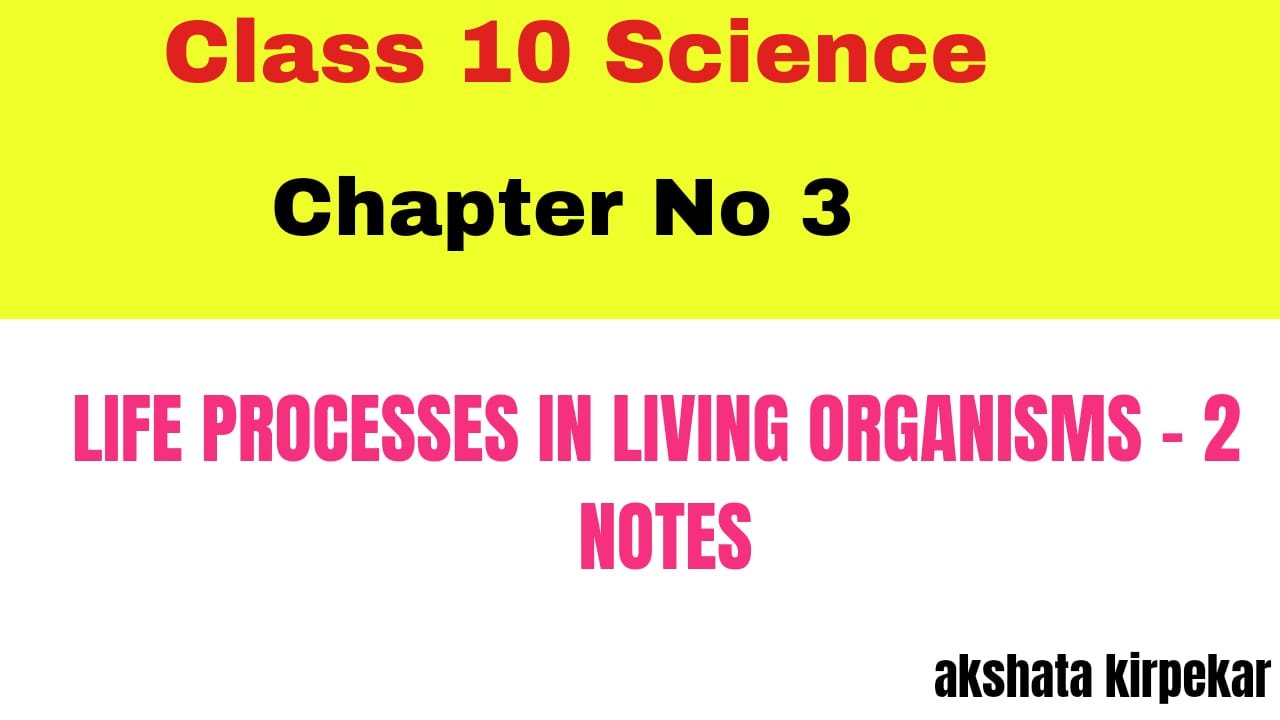Dear students, sharing with you LIFE PROCESSES IN LIVING ORGANISMS – 2 NOTES. I have made these notes in very easy language to make it easy to memorize and recall.
LIFE PROCESSES IN LIVING ORGANISMS-2
Reproduction –
Formation of new organism of same species by earlier existing organism is called as reproduction.
- Essential for survival of species on the earth.
- It ensures continuity of life.
- Responsible for evolution of species.
- Mainly occurs by 2 ways – asexual and sexual
ASEXUAL REPRODUCTION:
LIFE PROCESSES IN LIVING ORGANISMS – 2 NOTES
- Production of new organism from a single parent without involvement of gametes (sex cells)
- Does not involve union of gametes
- New organisms are genetically similar with parents
- Only one parent is involved (Uniparental)
- Occurs by mitotic / amitotic division
- Advantage – Fast process
- Disadvantage – Absence of genetic recombination

-
Asexual reproduction in unicellular organisms
LIFE PROCESSES IN LIVING ORGANISMS – 2 NOTES
Binary fission:
- Occurs in prokaryotes, protists and eukaryotic cell organelles like mitochondria and chloroplasts.
- Parent cell divides to form 2 similar daughter cells.
- Occurs either by mitosis or amitosis.
- Usually performed during favourable conditions.
The axis of division is different. On basis of axis, it is divided into –
Simple binary fission:
As amoeba is having irregular shape, the cell divides at any plane. (Ex, amoeba)

Transverse binary fission:
Division at transverse (Horizontal) plane (Ex, paramoecium)
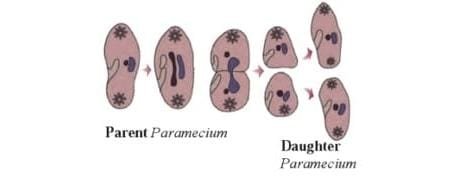
Longitudinal binary fission:
Division at longitudinal (vertical) plane (Ex. Euglena)

Multiple fission:
- Performed by amoeba and other protists during unfavourable conditions.
- Amoeba stops the formation of pseudopodia, becomes rounded and forms protective covering around plasma membrane called
- Many amebulae are formed by repeated division of nucleus and cytoplasm.
- Under favourable conditions, the cyst breaks and the amebulae are released.

Budding:
- Performed by unicellular fungus – yeast
- A small outgrowth – bud, comes out from the parent cell.
- Parent cell produces 2 daughter nuclei by mitosis of which one enters the bud and grows.
- After sufficient growth, the bud seperates from parent cell and lives independently.
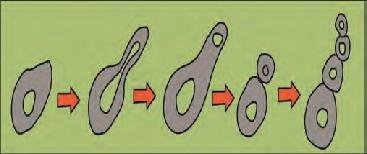
2. Asexual reproduction in multicellular organisms:
LIFE PROCESSES IN LIVING ORGANISMS – 2 NOTES
Fragmentation:
- Occurs in algae like spirogyra and sponges like sycon during favourable conditions.
- In favourable conditions, the parent body grows and breaks up into many fragments.
- Each fragment starts to live as an independent new organism.
- In sycon, when the body breaks up accidently, each fragment grows separately.

Regeneration:
LIFE PROCESSES IN LIVING ORGANISMS – 2 NOTES
- Occurs in Planaria.
- Under certain conditions, Planaria breaks up its body into parts, each part regenerates and thus the remaining body and new Planaria are formed.
- Limited regeneration – if accidently the tail of wall lizard breaks, after a period of time, the tail is regenerated.

Budding –
- Occurs in Hydra in favourable conditions
- Outgrowth – bud is formed on specific part of the body by repeated cell division
- The bud grows in size
- It takes nutrition from parent Hydra
- When the miniature Hydra attain maturity, it detaches itself from parent body and grows independently.

Vegetative propagation –
Occurs in some plants where reproduction takes place with the help of vegetative parts like roots, stem, leaf and buds.
All plants produced by vegetative propagation are similar to the parent
Ex potato –eyes on tuber; bryophyllum – buds on leaf margins; sugarcane, grass – buds on leaf nodes; carrot and radish – roots.
Spore formation:
- Occurs in fungus mucor
- It is having philamentous body having sporangia(spore bearing structures)
- Spores are formed in sporangia.
- When spores are matured, the sporangium breaks and spores are released.
- The spores germinate on moist surface and new fungal colony is formed.

SEXUAL REPRODUCTION –
LIFE PROCESSES IN LIVING ORGANISMS – 2 NOTES
It is the process of reproduction in which two parents are involved to produce offspring by fusion of male and female gamete.
It involves two main processes –
Gamete formation –
Meiotic division occurs due to which chromosome number is reduced to half. As a result haploid gametes are formed.(2n -> n)
Fertilization –
Haploid male gamete fuses with haploid female gamete to form diploid (2n) zygote. Zygote divides by mitosis to form embryo which later forms new individual.
Characteristics of sexual reproduction –
-
- It involves two parents.
- New individual has recombined genes of both parents.
- It plays important role in evolution
- It gives rise to diversity in living organisms
Sexual reproduction in plants:
Flower is the functional unit of sexual reproduction. It consists of 4 floral whorls – calyx, corolla, androecium (male reproductive structure), gynoecium (female reproductive structure)
Calyx and corolla are accessory whorls as they do not directly participate in reproduction process.
Androecium and gynoecium are essential whorls as they perform the function of reproduction.
Calyx – It is made of green coloured structures – sepals
Function – Protection of inner whorls
Corolla – It is made of brightly coloured structures – petals
Function – Attract pollinating agents for pollination
Androecium – It is male whorl. It is made up of structures – stamens
Structure of stamen –
Each stamen consists of 2 parts – anther and filament.
Anther – It consists of pollen grain which produce male gametes
When the pollen grains mature, the anther bursts and the pollen grains are released.
Function – Produces pollen grains that contain male gametes
Filament – It is the stalk of anther
Function – To connect the anther with flower
Gynoecium – It is the female reproductive part of flower and innermost in position. It is also known as pistil. The individual member of gynoecium is known as carpel
A typical carpel consists of three parts – stigma, style and ovary.
Stigma – It is a terminal part of carpel which receives pollen grains during pollination. It helps in germination of pollen grain.
Function – It holds the pollen grains on its surface to facilitate pollination and fertilization.
Style – It is narrow thread like structure that connects ovary with stigma.
Function –
- It connects stigma with ovary.
- Transfers the male gametes to ovary
Ovary –
- It is basal swollen fertile part of the carpel.
- Ovules are produced in ovary.
- Embryo sac is formed in each ovule by meiosis.
- Each embryo sac consists of a haploid egg cell and two haploid polar nuclei.
- (Ovary -> Ovules -> Embryo sac -> Egg cell)
Function – Produces one or many egg cells.
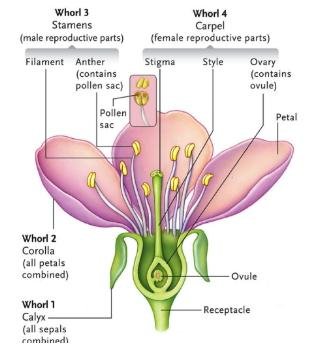
Different types of flowers –
Bisexual flower – Flowers with both androecium and gynoecium.
Ex. Lily, Rose, Sunflower, Tulip, Daffodil, Mustard, Brinjal, Hibiscus, Tomato, Long bean, Chili, Country bean, mango
Unisexual flower – Flower with either androecium or gynoecium.
Ex. Coconut flowers, Papaya, Watermelon, Cucumber, Maize, White mulberry, Musk melon, Castor, bean, Snake gourd, Bitter gourd, Tapioca, Pumpkin, Pine, etc.
Male flower – Flowers with only androecium.
Female flower – Flower with only gynoecium.
Pedicellate – Flowers with stalk.
Ex. Jasmine, Hibiscus, Rose
Sessile – Flowers without stalk
Ex. Wheat, Rice, Saffron
Pollination –
Transfer of pollen grains from anther to stigma is called pollination.
Pollination is brought about by either living (biotic) or non-living (abiotic) agents.
Examples of biotic agents – insects, birds, bats, snails, animals, etc.
Examples of abiotic agents – wind, water
Types of pollination –
Self-pollination – When pollination involves only one flower or two flowers born on same plant, it is called as self-pollination
Ex. wheat, barley, oats, rice, tomatoes, potatoes, apricots and peaches.
Cross pollination – when pollination involves two flowers born on two plants of same species, it is called cross pollination.
Ex. Pumpkins, grapes, grasses, apples, maple trees, etc
Fertilization –
LIFE PROCESSES IN LIVING ORGANISMS – 2 NOTES
- After a pollen grain reaches the surface of the stigma, it germinates and forms a pollen tube, which penetrates the stigma, style, and ovary and then enters ovule.
- The pollen tube carrying male gametes penetrates the embryo sac. One haploid male gamete fuses with haploid female gamete (egg) to produce diploid zygote.
- The second male gamete fuses with diploid secondary nucleus and forms triploid endosperm.
- The endosperm provides nutrition to the developing embryo.

Why fertilization in flowering plants is called double fertilization.
The pollen tube bursts and releases two male gametes in the embryo sac. One male gamete fuses with the egg cell to form zygote, whereas the second male gamete fuses with two polar nuclei in the embryo sac to form endosperm.
Since, in flowering plants the process of fertilization occurs twice in the same embryo sac, by two male gametes, it is called as double fertilization.
GERMINATION:
LIFE PROCESSES IN LIVING ORGANISMS – 2 NOTES
- Development of new plantlet from zygote after fertilization is called germination.
- Ovule develops into seed and ovary into fruit.
- When seeds fall on the ground, it germinates and the zygote develops into endosperm and new plant is formed.
LIFE PROCESSES IN LIVING ORGANISMS – 2 NOTES
Sexual reproduction in human beings:
Human male reproductive system:
Human male reproductive system consists of –
- Pair of testes:
Location:
- Present in the scrotal sacs (Scrotum) outside the abdominal cavity.
- It consists of numerous seminiferous tubules.
- Each seminiferous tubule has germinal epithelium which divides by meiosis and produce sperms.
- The sperm travels through different tubules like- rete testes, vas difference, ejaculatory duct, and urethra.
Function:
- Secretion of hormone –testosterone which brings about secondary sexual characteristics in males.
- Sperm production
2. Epididymis –
Long, coiled tube (6 m long) where spermatids are temporarily stored. Sperms undergo maturation here.
3. Vas deferens (vasa deferentia) –
Tubular structure that transports mature sperms to ejaculatory duct.
4. Seminal vesicles:
Two glands located on either side of the urinary bladder. Secrete seminal fluid.
5. Prostate gland:
Located just below the bladder, secretes prostatic fluid.
6. Cowper’s gland:
Two glands located on either side of urinogenital duct which secretes a sticky substance during mating, which eases the entry of penis into female genital tract.
7. Penis –
It is cylindrical and muscular male copulatory organ.
Its function is to deliver the sperms in the female reproductive system during copulation.
Other times, it removes urine from the body.
Semen – It is a milky fluid that is secreted by penis into the vagina during copulation. It consists of – about 400 million sperms, seminal fluid, prostatic fluid, some amount of secretion from Cowper’s gland and fructose sugar for providing energy to the sperms.

Human female reproductive system:
- Pair of ovaries:
Structure / location: Two oval shaped organs present on either side of abdominal cavity.
Function:
- Formation of egg cell
- Secretion of estrogen hormone brings about secondary sexual characteristics in females.
- Pair of oviducts/ fallopian tubes:
Structure: These are paired structures that connect uterus to ovaries.
- Cilia are present on the inner wall that push the oocyte towards uterus.
Function: Fertilization process occurs here.
3.Uterus:
- Structure: It is muscular bag like structure at the centre of abdominal cavity. It is having very strong and flexible muscles.
- Function: Growth and development of foetus.
- Vagina:
- Structure: It is the muscular tube like structure which is passage of uterus to outside.
- Function: Passage for intercourse (entry of sperms), menses and act as birth canal.
- Bulbo – urethral gland / Bartholin’s gland:
- Location: Present in pair in the vaginal wall.
- Function: It secretes sticky substance for lubrication during entry of penis into vagina and protection of vagina
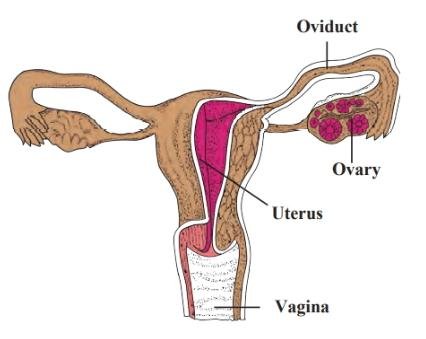
Gamete formation:
LIFE PROCESSES IN LIVING ORGANISMS – 2 NOTES
- Sperms (male gametes) eggs (female gametes) are formed by meiosis.
- Sperms are produced in testes from puberty till death.
- In woman, 2 to 4 million immature egg cells are present in the ovary of female foetus.
- In mature woman, a single matured egg cell (oocyte) is released from ovary every month.
- In woman, the functioning of reproductive system stops at menopause
Menopause:
- The natural stoppage of menstruation that occurs between the ages of 45 – 50 years is called menopause.
- The oocytes released from ovaries nearing menopause are 40 to 50 yrs. old and their ability of division has diminished.
- It occurs as the secretion of hormones controlling the function of the female reproductive system either stops or becomes irregular.
- If the eggs are fertilized, the children may have some abnormalities like Down syndrome.
Fertilization:
- It is the union of sperm and ovum to form zygote.
- In humans, the fertilization is internal in which semen is deposited in vagina during intercourse.
- Millions of sperms enter and start their journey by route of vagina through uterus and reach fallopian tubes(oviducts)
- Out of millions of sperms, only one sperm cell fertilize the ovum.
LIFE PROCESSES IN LIVING ORGANISMS – 2 NOTES
Development and birth:
- What happens after fertilization of ovum?
- The fertilization takes place in fallopian tubes. The zygote then formed undergoes rapid and repeated mitotic divisions to develop embryo.
- It then travels to uterus and gets implanted and grows for next 40 weeks or 9 months.
- Placenta is formed to supply food during its growth.
- The development is completed within 9 months after fertilization.
- After that the uterine wall start to contract and the baby is expelled out through the vagina.
Sex determination in human beings:
- The gametes develop from diploid (2n) germ cells.
- Each diploid cell contain 22 pairs of autosomes and 1 pair of sex chromosomes(allosomes) i.e. (44 +XX in females or 44 + XY in males)
- The germ cells undergo meiosis forming haploid (n) gametes having chromosomal combination 22 + X(in females) and 22+X/Y (in males)
- It means sperms contain 2 types of chromosomes either X or Y and the egg cell contains only one type of chromosome i.e. X.
- The sperm completes meiosis before they leave male reproductive tract and the egg completes meiosis after ovulation i.e. only if they are fertilized.
- The X chromosome is responsible for female sex while Y chromosome is responsible for male sex.
- If the sperm containing X chromosome fertilizes the egg then the child will be a female and if the sperm containing Y chromosome fertilizes the egg then the child will be male.
- Thus it is the sperm from father that decides the sex of individual
Menstrual cycle:
LIFE PROCESSES IN LIVING ORGANISMS – 2 NOTES
- Female reproductive system undergoes some changes that prepare the uterus for pregnancy at puberty and the changes repeat at interval of every 28 – 30 days. These repetitive changes are called menstrual cycle.
- It is controlled by 4 hormones –
- Follicle Stimulating Hormone (FSH, Luteinizing Hormone (LH) -from pituitary gland
- Oestrogen, Progesterone – from ovaries
- One ovarian follicle develops along with the oocyte present in it due to the effect of FSH.
- This developing follicle secretes oestrogen under the influence of FSH.
- Under the influence of oestrogen the inner wall of uterus (endometrium) develops or regenerates.
- The oocyte also undergoes development.
- The follicle becomes mature and it is called as Graafian follicle.
- After maturation, under the influence of LH, the follicle burst and oocyte is released. This process is called ovulation.
- The remaining tissue of empty Graafian follicle forms corpus luteum which secrete progesterone.
- The walls of endometrium become thick under the effect of progesterone and make the endometrium ready for implantation of embryo.
- If the oocyte is fertilized, pregnancy is maintained by progesterone till the period of breast feeding.
- If the oocyte is not fertilized, the corpus luteum becomes inactive and transforms into corpus albicans.
- Due to degeneration of corpus luteum, the secretion of oestrogen and progesterone stops completely and the endometrium starts to degenerate.
- The tissues of degenerating endometrium, unfertilized egg are discarded out through vagina along with some blood and mucus for approximately 5 days. This is called menstruation
Reasons/causes of sterility:
- Sterility in women
- Irregularity in menstrual cycle.
- Difficulties in oocyte production.
- Obstacles in the oviduct
- Difficulties in embryo implantation in uterus.
- Sterility in men
- Absence of sperms in the semen
- Slow movement of sperms
- Anomalies in sperms
Advanced medical techniques (modern reproductive technologies)
LIFE PROCESSES IN LIVING ORGANISMS – 2 NOTES
-
In vitro fertilization(IVF):
- Fertilization is brought about in the test tube.
- The sperm is injected into the ovum using micro pipette.
- The embryo formed after fertilization is implanted in the uterus at appropriate time.
- Useful for – couple having problems like less sperm count, obstacles in oviduct, etc.
2 Surrogacy:
- Oocyte is collected from ovary of the women and fertilized in test tube with the help of sperms collected from her husband.
- Embryo formed from fertilization is implanted in another woman (surrogate mother) having normal uterus.
- Useful for – women having problems with implantation of embryo in the uterus.
3 Sperm bank:
- This concept is similar to blood bank.
- The ejaculated semen from donor is collected after desired physical and medical check-up and stored in the sperm bank.
- It is used to fertilize the oocyte of the female partner of the concerned couple
- .Useful for – couples in which males have problems in sperm production.
Twins:
LIFE PROCESSES IN LIVING ORGANISMS – 2 NOTES
When 2 embryos develop simultaneously in the same uterus and 2 offsprings are delivered from the same pregnancy.
-
Monozygotic twins :
- Formed from single embryo.
- During early period of embryonic development (within 8 days from zygote formation), the cells of the single embryo divide into 2 groups and develop as 2 separate embryos.
- They are genetically exactly similar to Each other hence their appearance and gender is same.
Siamese twins –
- If the embryonic cells are divided into two groups 8 days after the zygote formation, there is a possibility of formation of conjoined twins.
- These are born with some parts of body joined to other. They may share some organs too.
2. Dizygotic twins –
- Occasionally two oocytes are released from the ovary and both are fertilized by two different sperms and zygotes are formed from which, two different embryos are developed and both of these are separately implanted in the uterus.
- These are genetically different and may be different gender also.
Reproductive health –
A person’s state of being physical, mental and social strongness is called as health.
Reason behind lack of awareness about reproductive health –
- Social customs
- Traditions
- Illiteracy
- Shyness
Due to lack of awareness some problems regarding reproductive health can arise also various sexually transmitted diseases can spreadEx. Syphilis, Gonorrhea
Syphilis Symptoms:
1) Occurrence of chancre (patches) on various parts of body including genitals
2) Rashes
3) Fever
4) Inflammation of joints
5) Alopecia (Hair fall)
Gonorrhea Symptoms:
1) Painful and burning sensation during urination
2) Oozing of pus through genitals
3) Inflammation of urinary tract, anus, throat, eyes, etc.
Population Explosion –
Excessive growth of population within short duration is called population explosion.
Effects of population explosion –
We have to face various problems like unemployment, decreasing per capita income, increasing loan, stress on natural resources, etc.
